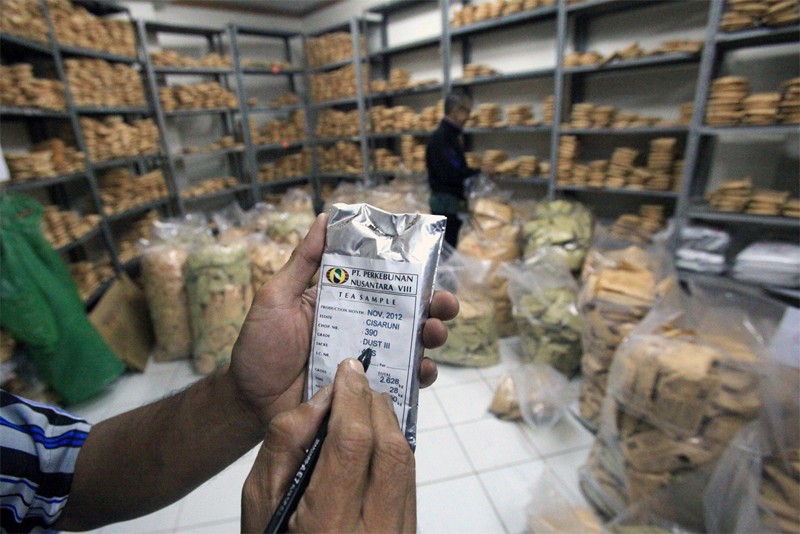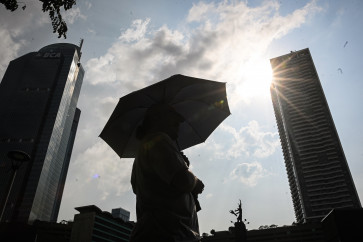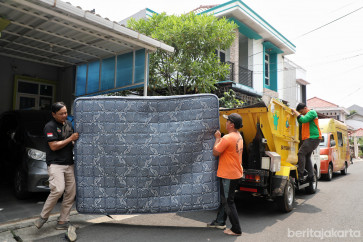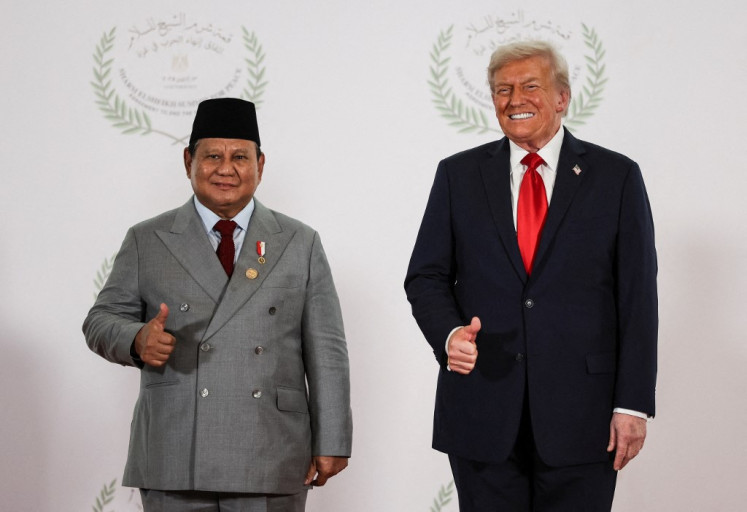Popular Reads
Top Results
Can't find what you're looking for?
View all search resultsPopular Reads
Top Results
Can't find what you're looking for?
View all search resultsBooming tea imports expose irony for Indonesia
Change text size
Gift Premium Articles
to Anyone
 Tea time: An official writes down information on a special bag containing a tea sample inside a tea archive room belonging to state-owned tea and coffee distributor, PT Kharisma Pemasaran Bersama Nusantara. Indonesia produced nearly 130,000 tons of tea last year but anxiety looms as the country has been facing volatile weather conditions that affect productivity levels at local tea plantations. (JP/R. Berto Wedhatama)
Tea time: An official writes down information on a special bag containing a tea sample inside a tea archive room belonging to state-owned tea and coffee distributor, PT Kharisma Pemasaran Bersama Nusantara. Indonesia produced nearly 130,000 tons of tea last year but anxiety looms as the country has been facing volatile weather conditions that affect productivity levels at local tea plantations. (JP/R. Berto Wedhatama)
A
s the world’s seventh-biggest tea producer, Indonesia has vast plantations to grow the commodity, but its rising imports show it cannot manage the huge potential at home.
Tea imports have skyrocketed to 25,000 tons in 2015 from only 500 tons in 1999, according to data from the Indonesia Tea Board (DTI).
The emerging middle class significantly drives the expansion of the premium tea-drinking culture. Mushrooming premium stores, such as TWG and high-end supermarkets, as well as hotels serving Twinings, Dilmah or imported Chinese tea leaves have boosted imports.
“It’s ironic that the rising trend of premium tea consumption is not supported by the tea-processing industry here. Alas, most of our raw tea is still exported [only] to be processed abroad and imported back here again,” said DTI chairman Rachmat Badruddin on the sidelines of Export Forum 2016 on Monday at Hotel Borobudur.
Only 40 percent of the total 130,000 tons of tea produced last year was processed at home, but mostly for the mass market, while 60 percent was shipped overseas.
Apart from the recent trend of premium tea drinks, the absence of non-trade barriers has weakened the local market.
The exemption of import duties for neighboring Southeast Asian countries under the ASEAN free trade agreement has contributed to easier imports, Rachmat said. Previously, Indonesia applied a 5 percent import duty for tea.
Imposing non-trade barriers, such as certifications from DTI prior to importation, may be necessary to curb this import boom, according to Rachmat.
“[Therefore] we shouldn’t import tea types that we already produce here,” he said.
At 20 percent, tariffs imposed on tea imports from non-ASEAN countries into Indonesia are much lower than the rest of the world, which can go as high as 140 percent.
The biggest bulk of imported tea derives from Argentina, Kenya, India, Iran and Vietnam.
With the lack of a domestic processing industry and the ease of exporting raw tea, especially for major exporters, it is no wonder that state-owned plantation firm PTPN VIII, Indonesia’s largest tea planter, sold 90 percent of its 45,000 tons of premium tea last year overseas.
The West Java-based planter mostly ships to Australia, China, Germany, Malaysia, the Netherlands, Pakistan, Russia, Taiwan, the UK and the US.
“We export it through big exporters like Yoosuf Akbani and Van Rees as well as to renowned brands, such as Twinings, Dilmah and consumer goods firms like Unilever and Lipton,” said PTPN VIII operational director Tatang Supriatna.
Only 10 percent of PTPN VIII’s production is made into popular premium tea-bags like Walini, mainly for domestic consumption.
The firm set a target of 2025 to process 40 percent of its total output to value-added tea products.
Although most firms sell their output abroad, tea export volume and value have dropped in the past decade due to shrinking areas for tea plantations, rising temperatures and dropping prices driven by global oversupply.
Tea exports from Indonesia, once the world’s fifth-largest producer, dropped to 62,700 tons last year from 92,000 in 2009, with the value dropping to US$128 million from $171 million all in the same period.
Only 6 percent of the 62,700 tons in export volume last year comprised value-added processed tea.
Areas growing the plant have dropped from 150,000 hectares to 120,000 ha at present as farmers prefer planting other cash crops with simpler maintenance like vegetables.
While big firms say it is easy to export, smaller firms like West Java-based CV Arafa Asia see more difficulty today in increasing exports.
“The documents required to export now are more complicated. I need to change my house building permit [IMB] into one for a business unit,” said Ipah Syarifah, who produces tea-based products, including tea crackers and green tea chocolates.









